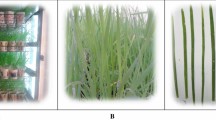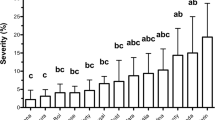Abstract
The healthy leaves of rice cultivar ‘BJ 1’ resistant to bacterial leaf streak pathogen (Xanthomonas translucens f. sp.oryzicola) contained higher quantities of total phenolic compounds, reducing and nonreducing sugars than the susceptible cultivar ’IR 8’, while the leaves of cultivar ’IR 8’ possessed larger concentration of total soluble amino acids than the resistant cultivar ’BJ 1’.
In the leaves of cultivar ‘BJ 1’, the disease development caused an initial decrease in the concentration of phenols followed by an increase at later stages. As a result of inoculation, soluble carbohydrates and amino acids generally decreased in the leaves of resistant cultivar ‘BJ 1’, in contrast to an increase in their concentration in the leaves of cultivar ‘IR 8’.
Abstract
Zdravé listy rýže cv. ‘BJ 1’ odolné proti bakteriálnímu patogenu pruhovitosti (Xanthomonas translucens f. sp.orizicola) obsahovaly vyšší množství celkových fenolických sloučenin redukujících a neredukujících cukry než neodolný cv. ‘IR 8’, zatímco listy kultivaru ‘IR 8’ měly vyšší koncentraci celkových rozpustných aminokyselin než odolný cv. ‘BJ 1’.
V listech cv. ‘BJ 1’ působila infekee počáteční snížení koncentrace fenolů, po kterém v pozdějších stádiích následoval vzestup. Očkováním se v listech odolného ‘BJ 1’ obsah rozpustných glycidů a aminokyselin snížil a naopak v listech cv. ‘IR 8’ jejich koncentrace stoupla.
Similar content being viewed by others
References
Bray, H. G., Thorpe, W. V.: Analysis of phenolic compounds of interest in metabolism.— Meth. biochem. Anal.1: 27–52, 1954.
Byrde, R. J. W., Fielding, A. H., Williams, A. H.: The role of oxidized polyphenols in the varietal resistance of apples to brown rot.—In:Pridham, J. B. (ed.): Phenolics in Plants in Health and Disease. Pp. 95–99. Pergamon Press, Oxford 1960.
Cruickshank, I. A. M., Perrin, D. H.: Pathological function of phenolic compounds in plant.— In:Harborne, J. B. (ed.): Biochemistry of Phenolic Compounds. Pp. 511–544. Acad. Press, New York 1964.
Farkas, G. L., Király, Z.: Role of phenolic compounds in the physiology of plant disease resistance.—Phytopathol. Z.44: 105–150, 1962.
Inman, R. E.: Disease development, disease intensity and carbohydrate levels in rusted bean plants.—Phytopathology52: 1207–1211, 1962.
Kirkham, D. S.: Significance of the ratio between the wate soluble aromatic and nitrogen constituents of apple and pear in the host-parasite relationship ofVenturia sp.—Nature173: 690 to 691, 1954.
Mahadevan, A.: Biochemistry of resistance in cucumber againstCladosporium cucumerinum.— Phytopathology54: 899–900, 1964.
Mahadevan, A.: Biochemistry of infection and resistance.—Phytopathol. Z.57: 96–99, 1966.
Moore, S., Stein, W. H.: Photometric method for use in the chromatography of amino acids.— J. biol. Chem.176: 367–388, 1948.
Neish, A. C.: Major pathways of biosynthesis of phenols.—In:Harborne, J. B. (ed.): Biochemistry of Phenolic Compounds. Pp. 295–359. Acad. Press, New York 1964.
Nelson, N.: A photometric adaptation of the Somogyi method for the determination of glucose. —J. biol. Chem.15: 375–380, 1944.
Rubin, B. A., Artsikhovskaya, E. V.: Biochemistry and Physiology of Plant Immunity. Pp. 158. Pergamon Press, Oxford 1963.
Sridhar, R.: Influence of nitrogen fertilization andPyricularia oryzae development on some oxidases, their substrates and respiration of rice plants.—Acta phytopathol. Acad. Sci. Hungary7: 57–70, 1972.
Sridhar, R., Ou, S. H.: Biochemical changes associated with the development of resistant and susceptible types of rice blast lesions.—Phytopathol. Z.79: 222–230, 1974.
Tagami, Y., Mizukami, T.: Historical review of researches on bacterial leaf blight of rice caused byXanthomonas oryzae (Uyeda et Ishiyama) Dowson.—Special Report Plant Disease and Insect Pests Forecasting Service. No. 10. Pp. 112. Plant Protection Division, Min. Agr. Forest., Japan 1962.
Thomson, R. H.: Structure and reactivity of phenolic compounds.—In:Harborne, J. B. (ed.): Biochemistry of Phenolic Compounds. Pp. 1–32. Academic Press, New York 1964.
Uritani, I.: The biochemical basis of disease resistance induced by infection.—In:Rich, S. (ed.): Perspectives of Biochemical Plant Pathology. The Conn. Agr. Exp. Sta. Bull. 663. Pp. 4–19. 1963.
Uritani, I., Akazawa, T.: Alteration of respiratory pattern in infected plants.—In:Horsfall, J. G., Dimond, A. E. (ed.): Plant Pathology. Vol. I. Pp. 349–390. Acad. Press, New York 1959.
Author information
Authors and Affiliations
Rights and permissions
About this article
Cite this article
Reddy, P.R., Sridhar, R. Influence of bacterial streak disease development on changes in phenolics, soluble amino acids and carbohydrates of rice leaves. Biol Plant 17, 363–367 (1975). https://doi.org/10.1007/BF02921162
Received:
Published:
Issue Date:
DOI: https://doi.org/10.1007/BF02921162




